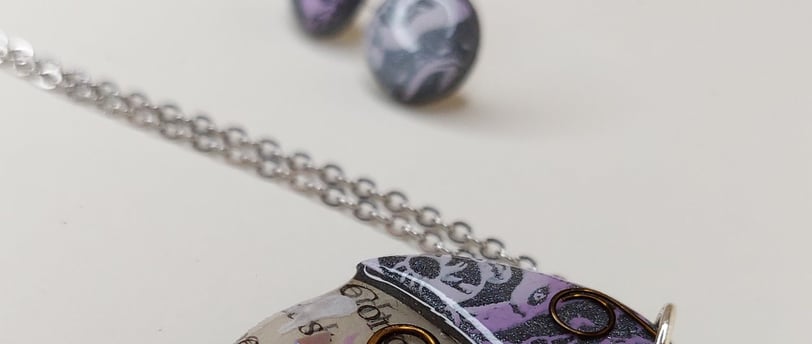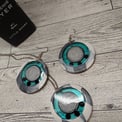Free Shipping on orders over $50
A Comprehensive Guide to Working with Polymer Clay for Jewelry and Crafts
8/30/20244 min read


Introduction to Polymer Clay: A Versatile Medium
Polymer clay is a remarkable crafting material that has gained immense popularity among artists and crafters alike. This unique medium is composed of polyvinyl chloride (PVC) resin and offers a malleable consistency that allows for an array of creative possibilities. Unlike traditional clays, polymer clay hardens upon baking, making it an ideal choice for producing durable and detailed pieces in jewelry making and various crafts.
One of the primary factors contributing to the widespread use of polymer clay is its versatility. Available in numerous colors, finishes, and even effects such as metallic, translucent, and glitter, this material enables creators to experiment with different textures and aesthetics. Beginners can start with simple projects, gradually progressing to more intricate designs as they build their skills. For advanced crafters, the possibilities are virtually limitless, as polymer clay can be molded, sculpted, and combined with various materials, such as beads, fabric, and metal, to create stunning pieces.
Polymer clay is also favored for its accessibility; it can be easily obtained at craft stores and online retailers, making it a staple in the crafting community. Additionally, it requires minimal tools for manipulation, often only needing a work surface, cutting tools, and an oven for curing. This simplicity makes polymer clay particularly attractive to those who may not have extensive crafting experience.
Overall, polymer clay offers a unique blend of creativity and functionality. It caters to a broad audience, from novices to seasoned artisans, thus solidifying its place as a fundamental resource for anyone interested in jewelry and crafts. Its multifaceted properties ensure that it remains a popular choice in the crafting landscape, inviting exploration and innovation in every project.
Pros and Cons of Working with Polymer Clay
Working with polymer clay presents a myriad of advantages that can enhance the creative process for jewelry makers and crafters. One of the most significant benefits is its lightweight nature, which makes it a preferred material for wearable art. This characteristic allows artists to create intricate designs without the bulk and weight that may detract from the final piece. Moreover, the vast color palette available in polymer clay enables limitless personalization and artistic expression. Artists can choose from a wide array of colors and can even mix different shades to create unique hues tailored to their specific projects.
Another notable advantage is the sculptability of polymer clay. It is a versatile medium that can be easily shaped, molded, and textured, allowing for both detailed designs and abstract forms. This adaptability makes it suitable for a range of projects, from delicate jewelry pieces to larger decorative items. Additionally, polymer clay is generally easy to work with, making it an accessible choice for both beginners and seasoned artists.
However, there are also some disadvantages worth considering. One of the primary concerns is the material's susceptibility to cracking. While polymer clay is durable, it can become brittle if not handled properly or if it is overworked during the crafting process. Furthermore, to harden polymer clay, it needs to be baked at specific temperatures. This requirement may pose logistical challenges for some artists, particularly in terms of ensuring consistent baking conditions. Furthermore, there is also the need for proper ventilation during the baking process to avoid exposure to any potentially harmful fumes.
In recognizing these pros and cons, it becomes easier for crafters and jewelry makers to make informed decisions regarding the use of polymer clay in their creative endeavors.
Creative Ideas for Jewelry and Crafts with Polymer Clay
Polymer clay offers a versatile medium for crafting an array of beautiful jewelry and decorative items. Whether you are a beginner or an intermediate crafter, there are countless project ideas that can unleash your creativity while reinforcing your skills. One of the simplest projects to start with is creating personalized earrings. By using cookie cutters or molds, you can make unique shapes, such as hearts, stars, or natural elements, adding vibrant colors to make your pieces truly stand out.
Another popular and straightforward option is crafting keychains. By incorporating initials, favorite symbols, or miniaturized versions of animals, you can create functional and aesthetically pleasing accessories. Adding tassels or beads to these keychains can elevate their design. If you are interested in delving into more complex projects, consider designing decorative items for your home. For example, creating custom coasters, picture frames, or decorative bowls can blend functionality with artistic expression, allowing you to showcase your artistic abilities.
When it comes to working with polymer clay, customizing shapes and colors is key to developing your unique style. To achieve various textures and designs, tools like silicone molds, dotting tools, and texture sheets can be incredibly helpful. Additionally, experimenting with color mixing can lead to stunning results, enabling you to create gradients or marbled effects that bring your projects to life.
Lastly, do not overlook intricate sculptures, which can range from abstract forms to representational art. Begin with small figures, practicing techniques such as blending and shaping until you feel confident enough to tackle larger projects. With polymer clay, the only limit is your imagination. Keep experimenting, and it will lead you to endless possibilities.
To embark on your journey with polymer clay, acquiring the right tools is essential. A basic toolkit will ensure that you have everything you need to create intricate designs and jewelry pieces. Start with a sturdy work surface to protect your tables, followed by a set of acrylic rollers for even flattening of the clay. Small and large cutters will help shape your creations, while a crafting knife is essential for detailed work. Additionally, a pasta machine can be particularly beneficial for conditioning the clay and achieving uniform thickness.
Once you have your tools, understanding the techniques to use them effectively is paramount. Conditioning polymer clay is the first step, which involves kneading and softening the material to make it pliable. This process helps eliminate air bubbles and prepares the clay for shaping. After conditioning, you can begin shaping your designs. Use your hands or sculpting tools to form your pieces, ensuring a smooth finish. Pay attention to details and textures, as these will elevate your final product.
After crafting, baking the polymer clay is crucial for durability. Preheat your oven to the temperature specified by the manufacturer—usually between 265°F and 275°F (130°C to 135°C). Place your creations on a baking tray lined with parchment paper and allow them to bake according to the recommended time. Overbaking can cause discoloration and brittleness, while underbaking may prevent the clay from hardening properly. Once baked, let your pieces cool completely before handling. Employing these foundational tools and techniques will set you on the right path toward successful polymer clay projects, helping unleash your creativity in crafting unique items.
Getting Started: Tools and Techniques for Successful Polymer Clay Projects






